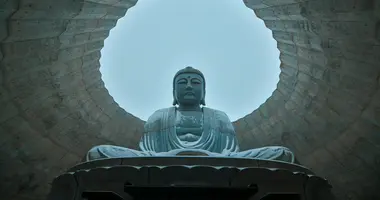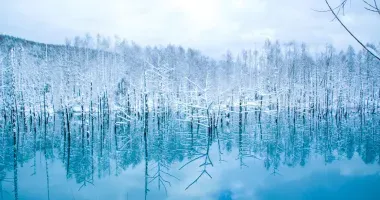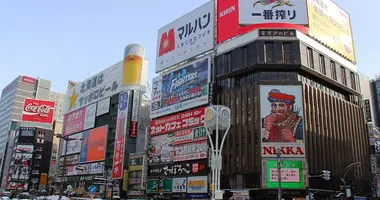Sounkyo Onsen: A scenic hot spring resort in Hokkaido's Daisetsuzan National Park
- Published on : 03/07/2024
- by : Japan Experience
- Youtube
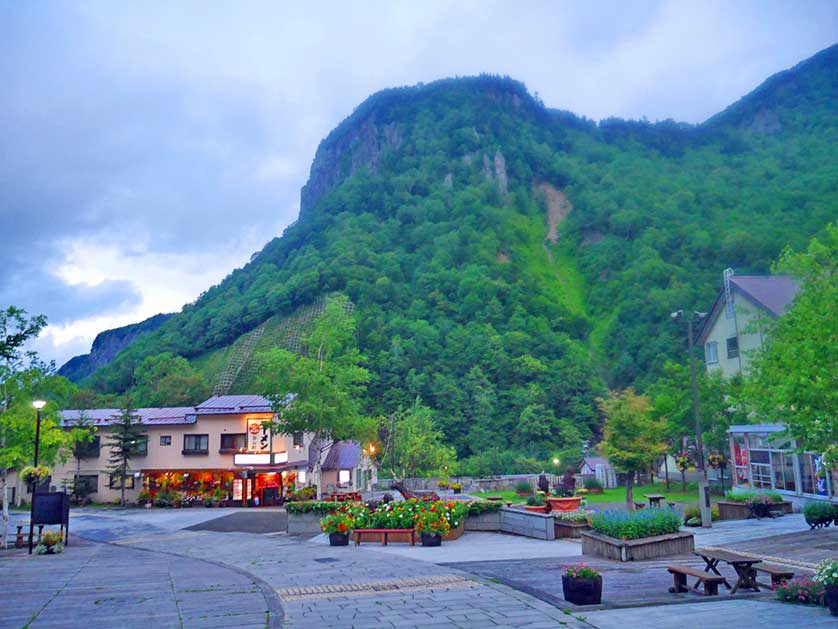
Nestled in the heart of Hokkaido, Sounkyo Onsen is a picturesque hot spring resort that captivates visitors with its stunning natural beauty and rejuvenating waters. Located within the Daisetsuzan National Park, Japan's largest national park, this charming town offers a perfect blend of modern comforts and traditional onsen experiences. With its origins rooted in Ainu culture, Sounkyo, meaning "the river with many waterfalls," lives up to its name with breathtaking waterfalls, towering cliffs, and pristine forests. Whether you're seeking relaxation, outdoor adventures, or a glimpse into Japanese hot spring culture, Sounkyo Onsen promises an unforgettable journey through Hokkaido's natural wonders.
Location and natural beauty of Sounkyo Onsen
Sounkyo Onsen is situated in a scenic, narrow gorge within the northern part of Daisetsuzan National Park. The resort town is flanked by 100-meter high, forested cliffs, creating a dramatic backdrop for visitors. The area's natural beauty is further enhanced by the Ishikari River that runs through the gorge, stretching over 20 kilometers.
One of the most captivating features of Sounkyo Onsen is its proximity to two stunning waterfalls: Ginga no Taki (Milky Way Falls) and Ryusei no Taki (Shooting Star Falls). Located about three kilometers east of the village center, these waterfalls cascade down the 100-meter high cliffside, offering a mesmerizing spectacle for nature enthusiasts. Visitors can view these natural wonders from a large parking lot across the river or take a short hike to a small observation deck for a closer look.
Another noteworthy attraction is Obako, a beautiful rock formation along the river that resembles folding screens. Located five kilometers up the valley, Obako showcases the raw beauty of the area's geological features. While a cycling road once connected these attractions, visitors now typically access them by taxi or rental car due to limited public transportation options.
Sounkyo Onsen is also renowned for its autumn foliage, being one of the first places in Japan to witness this seasonal spectacle. The vibrant colors typically begin to appear around the summit of Mount Kurodake in mid-September, gradually descending the mountain slopes until they reach the valley floor by mid-October, painting the landscape in a breathtaking array of reds, oranges, and golds.
Hot spring bathing experiences in Sounkyo
At the heart of Sounkyo Onsen's appeal are its rejuvenating hot springs, rich in sulfuric minerals known for their therapeutic properties. The town offers a variety of bathing options, catering to different preferences and ensuring a memorable onsen experience for all visitors.
The most famous public bath house in town is Kurodake No Yu, located in the town center. Despite its modest size, it's considered the most authentic hot spring experience in Sounkyo. The facility features small outdoor baths, an indoor bath, and a relaxation room. Open from 10am to 9pm, it offers an affordable entry fee of 600 yen, with possible discounts available through local accommodations.
For those seeking a more luxurious experience, the Sounkyo Kankou Hotel boasts modern facilities, including a sauna and a variety of indoor and outdoor baths. The highlight is the new bath, Utari, built with local rocks and overlooking a grand 6-meter high waterfall. Non-hotel guests can enjoy these facilities from 12pm to 4pm for 600 yen.
Another notable option is the Choyotei Hot Spring, offering a more upscale bathing experience. With its classical Japanese architecture, wooden baths, and panoramic mountain views, it provides a serene atmosphere for relaxation. Although slightly pricier at 1,000 yen, the less crowded environment ensures a peaceful soak.
Many ryokan in the area also open their baths to non-staying guests during the day, typically charging around 1,000 yen for admission. This allows visitors to experience a variety of hot spring settings and find their perfect bathing spot amidst Sounkyo's natural beauty.
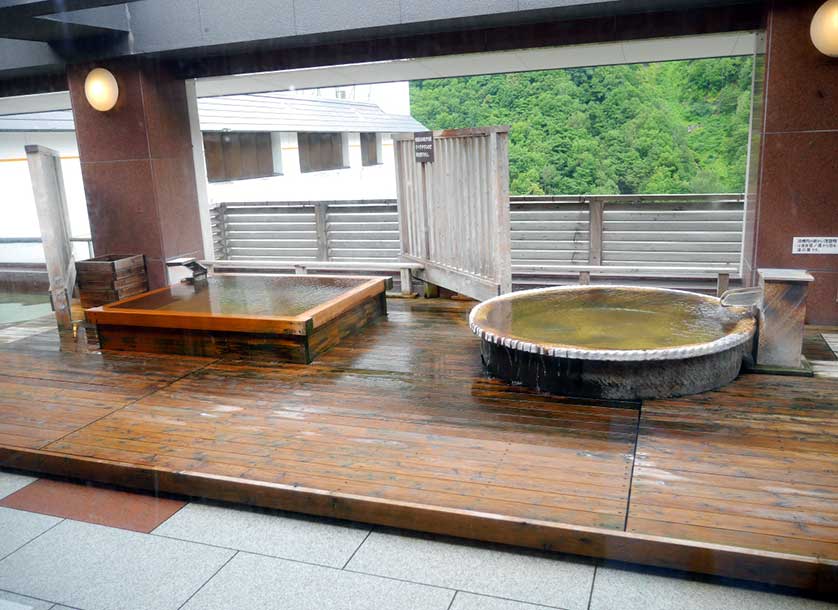
Choyotei Hot Spring, Sounkyo Onsen, Hokkaido Prefecture
Outdoor attractions and activities
Sounkyo Onsen serves as an excellent base for exploring the diverse outdoor attractions of Daisetsuzan National Park. The area offers a wealth of activities for nature lovers and adventure seekers throughout the year.
One of the most popular attractions is Mount Kurodake, a 1,984-meter peak towering over Sounkyo Onsen. The Kurodake Ropeway provides easy access to the mountain, departing from the Sounkyo Visitor Center. At the top of the ropeway, a chair lift brings visitors closer to the summit. From here, it's a steep 60-90 minute climb to the peak, rewarding hikers with breathtaking views of the Daisetsuzan mountains.
For more adventurous hikers, Mount Kurodake serves as a starting point for longer treks into the national park's interior. A popular route connects Kurodake to Mount Asahidake and Asahidake Onsen, typically completed in 1-2 days. More experienced hikers can even embark on a week-long north-south traverse of the entire national park from this point.
In addition to hiking, Sounkyo Onsen offers excellent opportunities for cycling, wildlife watching, and photography. Lucky visitors might spot deer and other wildlife roaming the mountains and forests. The area's dramatic landscapes, including the gorge, waterfalls, and rock formations, provide ample subjects for photography enthusiasts.
During the winter months, Sounkyo transforms into a winter sports haven. The Kurodake Ski Area, operating from mid-November to early June, boasts Japan's longest ski season. While it may not have many courses, it offers a unique backcountry experience with steep, deep powder and minimal crowds. Off-piste skiing is allowed for those with proper experience and avalanche gear.
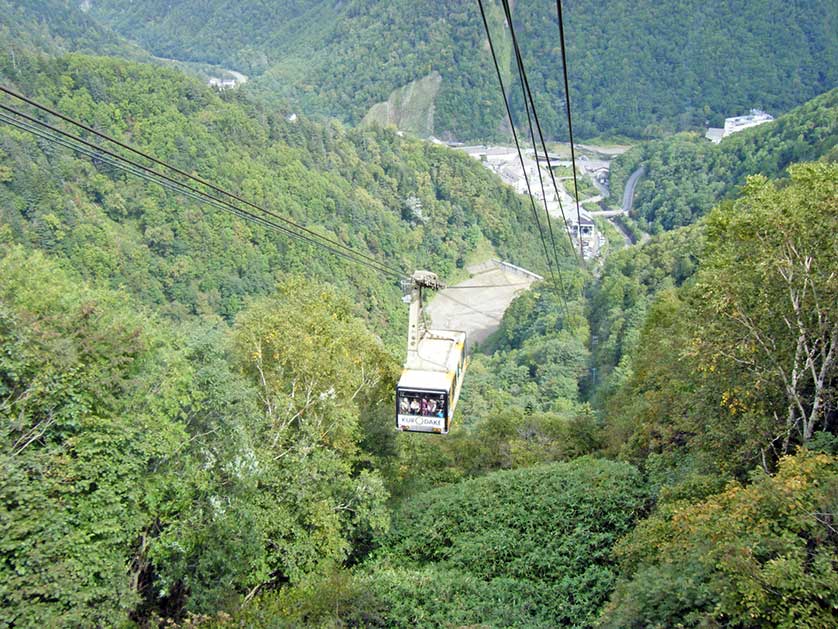
Ropeway, Sounkyo Onsen, Hokkaido Prefecture
Seasonal highlights and events
Sounkyo Onsen offers unique experiences and events throughout the year, making it an attractive destination regardless of the season.
In winter, the town hosts the renowned Sounkyo Ice Waterfall Festival (Sounkyo Onsen Hyobaku Matsuri). Running from late January to mid-March, this spectacular event transforms the frozen Ishikari River into a winter wonderland. Visitors can marvel at large, multi-story ice and snow structures, complete with interior caverns and maze-like tunnels. The festival grounds are illuminated in the evenings, creating a magical atmosphere. Highlights include ice sculptures, a snow tubing run, and an event stage. On selected evenings, visitors can enjoy small fireworks displays, adding to the festive ambiance.
Spring brings the awakening of nature, with the snow melting to reveal lush greenery and wildflowers. This season is ideal for hiking and enjoying the refreshing mountain air.
In summer, Sounkyo Onsen becomes a hub for outdoor activities. Visitors can explore the numerous hiking trails, enjoy picnics by the waterfalls, or participate in guided nature walks. The town also hosts the Sounkyo Onsen Fire Festival, celebrating the culture of the Ainu, Hokkaido's indigenous people. This event features the centuries-old Fukuro (Owl) Ritual, traditional music and dance performances, taiko drumming, and a spectacular fireworks display.
Autumn is perhaps the most visually stunning season in Sounkyo Onsen. As one of the earliest places in Japan to see fall colors, the area transforms into a canvas of vibrant reds, oranges, and golds. The autumn foliage typically begins at the summit of Mount Kurodake in mid-September and gradually descends to the valley floor by mid-October, attracting photographers and nature enthusiasts from across the country.
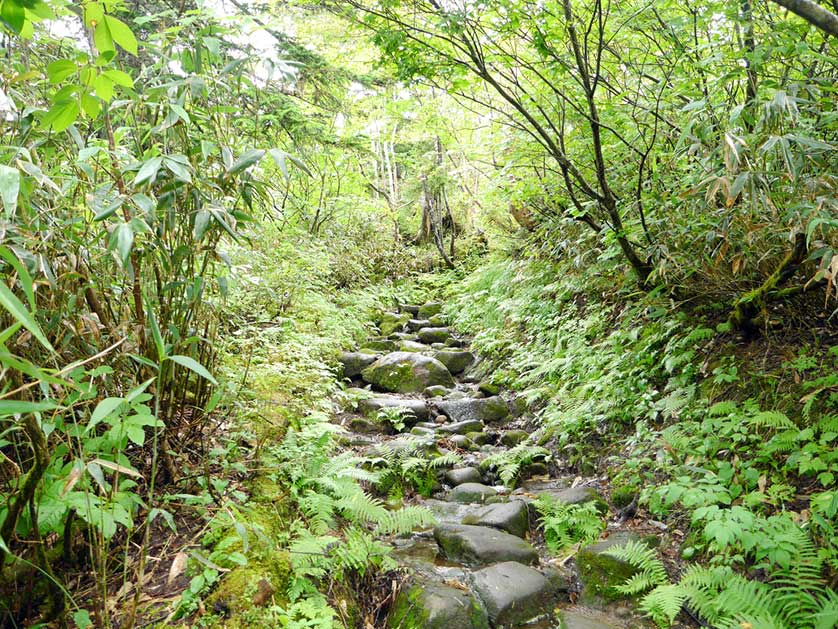
Hiking up Mount Kurodake, Sounkyo Onsen, Hokkaido Prefecture
Accommodation options in Sounkyo Onsen
Sounkyo Onsen offers a range of accommodation options to suit various preferences and budgets, ensuring a comfortable stay for all visitors.
The Sounkyo Kankou Hotel is one of the most popular choices in town. It boasts its own hot spring facilities, excellent service, and a convenient location near a 7-Eleven store. This hotel is ideal for those seeking a blend of modern amenities and traditional Japanese hospitality.
For travelers looking for a more budget-friendly option with a traditional touch, Sounkyo Onsen Kumoi is an excellent choice. This ryokan offers traditional Japanese tatami rooms while still providing modern conveniences such as Wi-Fi. It's a perfect option for those who want to experience authentic Japanese accommodations without breaking the bank.
Other notable accommodations include:
- Hotel Taisetsu: A comfortable hotel option with its own onsen facilities.
- Yumoto Ginsenkaku: A traditional ryokan offering a more intimate Japanese inn experience.
- Choyo Tei: This hotel provides a shuttle service from Sapporo Station, making it convenient for those traveling from Sapporo.
In addition to these, Sounkyo Onsen offers a variety of other ryokan and minshuku (family-run bed and breakfasts) at various price points. These smaller establishments often provide a more personal touch and can be an excellent way to experience traditional Japanese hospitality.
When choosing accommodation, consider factors such as proximity to the town center, onsen facilities, meal plans (many ryokan offer half-board with breakfast and dinner included), and whether they provide shuttle services to nearby attractions or transportation hubs.
Access and transportation to Sounkyo Onsen
Reaching Sounkyo Onsen is relatively straightforward, with several transportation options available:
By Bus: The most direct way to reach Sounkyo Onsen is by bus from Asahikawa. Direct buses operate between Asahikawa Station and Sounkyo Onsen, taking approximately 2 hours and costing 2,140 yen one way. These buses run every 1-2 hours, making it a convenient option for most travelers.
By Train and Bus: An alternative route is to take a JR train from Asahikawa to Kamikawa Station (40 minutes by limited express train or 70 minutes by local train), and then catch a bus from Kamikawa to Sounkyo Onsen (30 minutes). This option might be preferable for those with a Japan Rail Pass.
By Air: The nearest airport is New Chitose Airport near Sapporo. From here, you can take a train to Asahikawa and then proceed by bus to Sounkyo Onsen. Alternatively, Asahikawa Airport offers flights from Tokyo and Nagoya, with a bus connection to Asahikawa Station.
By Car: For those who prefer more flexibility, driving to Sounkyo Onsen is an option. The journey from Asahikawa takes about 1 hour and 30 minutes. Rent a car offices are available at major airports and train stations in Hokkaido.
Once in Sounkyo Onsen, most attractions within the town are within walking distance. For trips to nearby waterfalls or other attractions in Daisetsuzan National Park, taxis or rental cars are the most convenient options due to limited public transportation in the area.
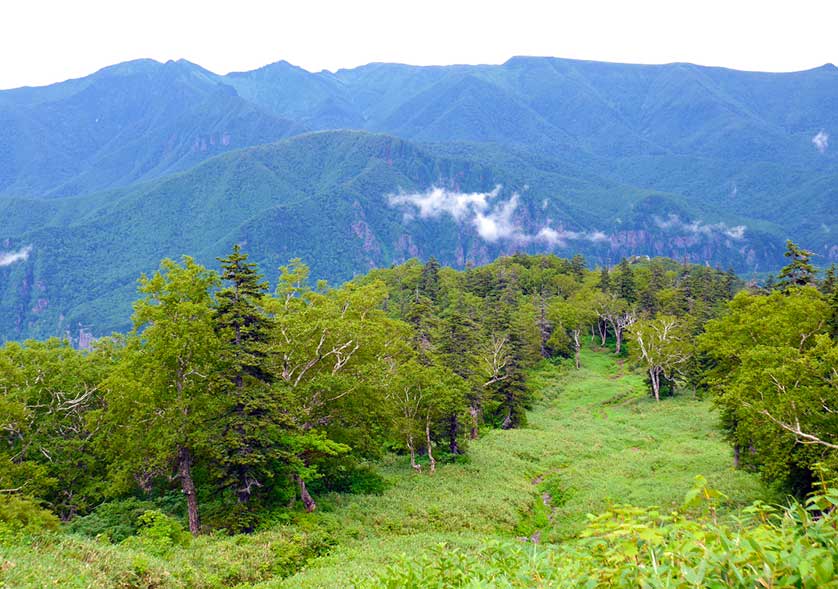
Near the summit of Mount Kurodake, Sounkyo Onsen, Hokkaido Prefecture
Practical information for visitors
To ensure a smooth and enjoyable trip to Sounkyo Onsen, here are some practical tips and information:
Tourist Information: The Sounkyo Onsen Tourist Information Center (Tel: 01658-5-3350) is located in the bus terminal near the post office. It's open daily from 10:30am to 5pm and can provide maps, local information, and assistance with accommodation bookings. The staff's English may be limited, but they can generally point you in the right direction.
Best Time to Visit: Sounkyo Onsen is beautiful year-round, but the best time to visit depends on your interests. For autumn colors, plan your trip between mid-September and mid-October. Winter sports enthusiasts should visit between November and May. Summer offers pleasant temperatures for hiking and outdoor activities.
Onsen Etiquette: If you're new to onsen culture, remember to wash thoroughly before entering the bath, don't wear swimsuits in the baths, and tie up long hair. Tattoos may not be allowed in some public baths, so check in advance if this applies to you.
Weather: Sounkyo Onsen experiences cold winters with heavy snowfall and mild summers. Always check the weather forecast before hiking or engaging in outdoor activities, as mountain weather can change quickly.
Money: While more businesses are starting to accept credit cards, it's advisable to carry cash, especially for smaller establishments and local shops.
Language: English is not widely spoken in Sounkyo Onsen. Consider bringing a translation app or a Japanese phrasebook to help with communication.
Hiking Safety: If planning to hike, especially in the more remote areas of Daisetsuzan National Park, inform your accommodation of your plans, carry appropriate gear, and be aware of wildlife, including bears.
By keeping these tips in mind and planning ahead, you can fully enjoy the natural beauty, relaxing hot springs, and unique experiences that Sounkyo Onsen has to offer. Whether you're soaking in an outdoor bath, hiking through colorful autumn foliage, or marveling at ice sculptures, Sounkyo Onsen promises a memorable stay in one of Hokkaido's most picturesque locations.
For more information about traveling in Japan, check out our Japan City Guides and Travel Books on Japan.
